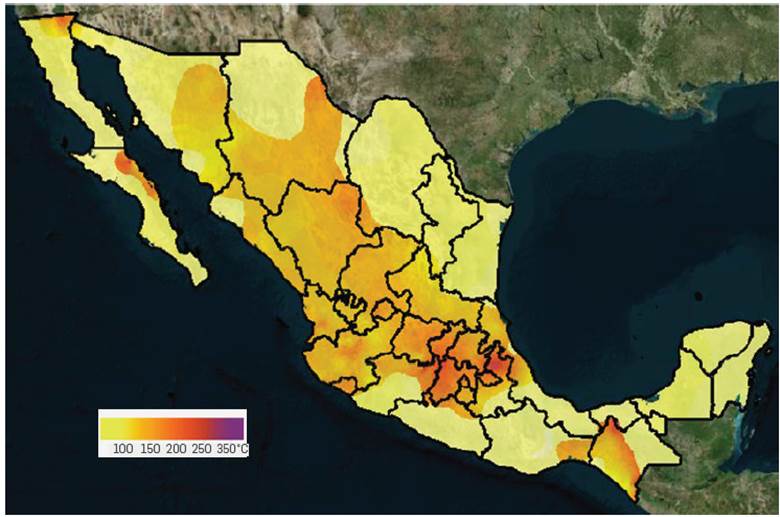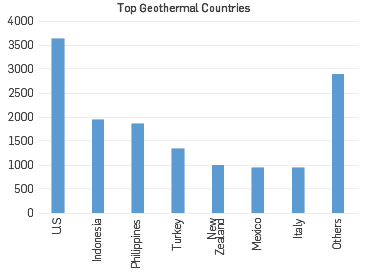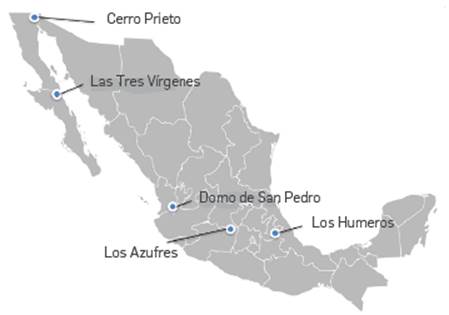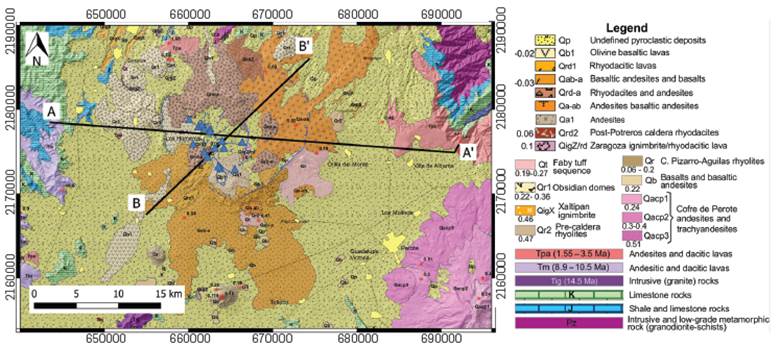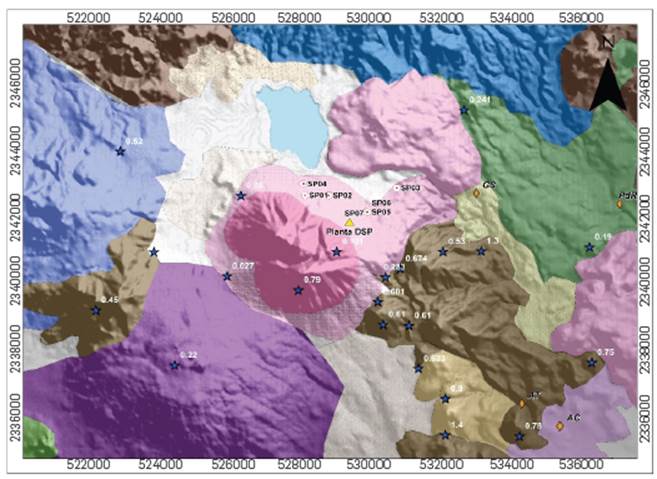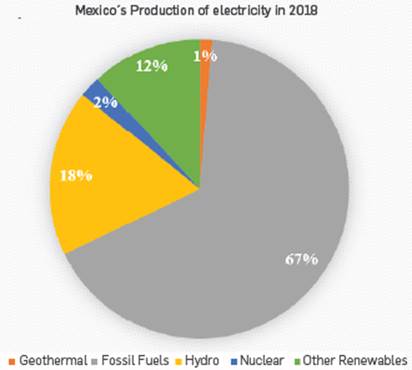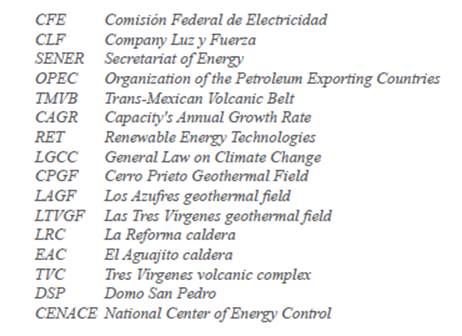1. INTRODUCTION
Geothermal energy is the thermal energy stored in the solid crust of the Earth. This type of energy is often used to generate geothermal electricity.
Some of the key technologies used in geothermal power generation projects include:
Geothermal Power Plants: These facilities use the heat extracted from the Earth to produce electricity. There are three main types of geothermal power plants:
Dry Steam Power Plants: These plants tap into underground steam reservoirs, then using the stream to directly drive turbines and generate electricity.
Flash Steam Power Plants: These plants draw high-pressure hot water from the reservoir and allow it to rapidly expand into steam, which is then used to drive turbines.
Binary Cycle Power Plants: These plants use lower-temperature geothermal resources by extracting hot water or steam from the reservoir and transferring its heat to a separate, secondary fluid with a lower boiling point. The secondary fluid vaporizes and drives the turbines, while the original geothermal fluid remains untouched.
Geothermal Heat Pumps: These systems use the relatively constant temperature of the ground to provide heating and cooling for buildings. They circulate a fluid through underground pipes, transferring heat from the ground into buildings during the winter, and removing heat from buildings during the summer.
Enhanced Geothermal Systems (EGS): EGS technology is aimed at creating geothermal reservoirs in areas that lack naturally occurring high-temperature resources. It involves the process of injecting water into the hot rock underground to create fractures, which allows the water to circulate and heat up. The heated water is then extracted and used to generate electricity.
Geothermal Direct Use: This technology involves using geothermal resources directly for applications other than electricity generation. For example, hot water or steam can be used for heating buildings, industrial processes, greenhouse cultivation, or even spa and wellness resorts.
These are some of the prominent technologies used in geothermal energy projects. Each technology has its own advantages, and is selected based on the specific geothermal resource available and the energy demands of the region. Unlike other renewable energy sources, geothermal energy is not limited to seasons, time, and specific conditions, and can be used continuously. The cost of electricity in geothermal power plants is competitive with that of electricity produced by other conventional power plants, and it is often cheaper than other types of renewable energy. The potential of renewable energy in different countries has been discussed in several articles (Akyürek, 2018; Santos-Herrero et al., 2017; Sharma et al., 2021; Uğurlu & Gokcol, 2017).
Geothermal energy is renewable from the natural heat of the core layers of the Earth. Energy recovered from these layers is used for desalination, heating, cooling, and power generation (Aryanfar, 2020; Assad et al., 2021; El Haj Assad et al., 2021; Fan et al., 2021; Pishkariahmadabad et al., 2021). Geothermal energy stored on Earth for thousands of years is derived from the decay of radioactive elements deep inside the Earth. The Earth beneath our feet is a tremendous source of energy. This energy, which is conducted in the form of heat from the depths of the Earth to its surface and, if its extraction technology is developed, it will meet all the energy needs of today, and the future of humanity as well.
According to calculations, the thermal energy stored in 11 km of Earth's upper crust is equivalent to 50,000 times the total energy obtained from the world's known oil and gas resources. Therefore, this energy source is a reliable alternative to fossil fuel power (Boyd, 2015; Stefansson, 2005). The excess heat from Earth's creation contained within the globe is geothermal energy. Although it is a relatively abundant energy source, it is not equally distributed, and it is found at considerable depths, thereby challenging its commercial extraction. Geothermal energy has an advantage over other renewable energy sources as it is impervious to the influence of weather and seasons.
Hence, it may reach a 95% capacity factor (Buscheck et al., 2017; Flores-Armenta et al., 2014; Mines et al., 2015; Sanyal & Butler, 2010). The three categories of geothermal resources are hot rock "dry" resources, and low- and medium-temperature hydrothermal resources. Only these technologies are used to generate power, and the heat from the geothermal fluid is recovered through heat exchangers to vaporize an organic fluid with a boiling point lower than that of water; then, the steam is pumped to a turbine.
In Mexico, two public utilities generate, transmit, distribute, and sell electricity: the Comisión Federal de Electricidad (CFE) and the Company Luz y Fuerza (CLF) (Hiriart & Gutiérrez-Negrin, 2003). The Mexico's geothermal potential varies depending on the source. According to SENER, the entire resource potential is 13.5 GW. Recent studies have indicated that typical hydrothermal technologies have a capacity range of 948-2,310 MW. In contrast, hot and dry resources demand upgraded geothermal system technologies with a capacity range of 5,250-24,700 MW (Goldstein et al., 2011; Gutiérrez-Negrín, 2012).
The Mexican government and foreign organizations have financed Mexico's academic and research institutes to further explore, map techniques, and analyze potential resources more appropriately. In December 2002, Mexico had 37,682 MWe of installed power capacity, with 853 MWe of geothermal power built at the Cerro Prieto, Los Azufres, Los Humeros, and Las Tres Vírgenes fields (Hiriart & Gutiérrez-Negrin, 2003). According to Gutiérrez-Negrin et al. (2015), the installed electric capacity of the country was 62,475 MWe in 2013 (Gutiérrez-Negrín, 2012). Mexico's installed capacity was 75,680 MWe in 2017, with conventional energy accounting for 70.5%, and renewable energy for only 29.5% (Diezmartínez, 2021). Although fossil fuels have remained dominant since the Energy Reform, renewable energy sources have gained traction, and government projections indicate that the electrical sector will continue giving priority to clean energy in the future decade. In December 2019, Mexico's total installed electric power capacity was 70,053 Mwe (Luis C.A. Gutiérrez-Negrín, 2020); however, the ENER project installed 66.91 GW between 2018 and 2032, with renewable energy technologies accounting for 55% of the total (Energía, 2018). According to CFE's Geothermal Power Project Management division, approximately 1,300 thermal stations have gathered since 1983 to estimate Mexico's underground temperatures. Figure 1 shows an area in the southeast that lacks a geothermal plant near the Guatemalan border. The picture also shows the Trans-Mexican Volcanic Belt, and various populated areas, including Mexico City and Querétaro (Francisco Flores-Espino, 2017). This study evaluated the state of geothermal energy in Mexico, and the state of geothermal fields. Mexico is one of the leading countries in the use of geothermal energy, with decades of experience.
The main objectives of this study are as follows:
Examining the current situation and the potential of Mexico in terms of exploitation of geothermal energy resources.
Introducing the five geothermal fields and their functional capacity in Mexico
Presenting scenarios related to the future of Mexico's energy with emphasis on geothermal energy sources.
In this study, after the introduction of geothermal energy and the introduction of geothermal energy into Mexico, the potential of geothermal exploitation in Mexico and Mexico's position in the world are discussed. Next, five geothermal fields are introduced in Mexico, and the potential and capacity of each are discussed. Finally, future energy scenarios for Mexico are reviewed, with emphasis on geothermal energy.
2. CURRENT GEOTHERMAL CAPACITY IN MEXICO
The relative position in the international system is affected by a number of factors that include population, land area, natural resources, geostrategic status, military resources, and soft power. Control and access to primary energy sources and markets are significant assets, and governments that lacking these resources are more sensitive and responsive to energy development. Therefore, the growth and development of renewable energy in countries will change the relative power and influence of some governments, making it possible to restructure the geopolitical map of the 21st century. Undoubtedly, many energy-based alliances and institutions such as OPEC are weakened. Some strategic relations between governments, such as strategic alliances between the United States and Saudi Arabia, will change.
On the contrary, many new treaties and unions have arisen from the exchange of renewable energy technology. Geothermal energy has been used in Mexico for several decades. The first geothermal power plant was built in 1959, and it has produced electricity from geothermal energy continuously since 1973 (Quijano-León & Gutiérrez-Negrín, 2003). Mexico has the largest installed geothermal capacity worldwide, with 1005.8 MW, an installed capacity of 947.8 MW, and operational capacity as of December 31, 2018 (Luis C. Gutiérrez-Negrín, 2020). Figure 2 shows the top countries producing geothermal energy. As can be noted, Mexico is the sixth largest producer of geothermal energy globally.
The conditions for each of the top countries in the field of geothermal energy are the following:
3,639 MW in the United States, with a further 48 MW constructed shortly before the year's conclusion.
Indonesia, 1,948 MW, with an additional 95 MW set to come online by the end of the year.
Philippines, 1,868 MW, no word on projects slated to begin this year.
Turkey, 1,347 MW: To leverage on the advantageous feed-in rates, a considerable capacity was made available just before the end of the year.
New Zealand, 1,005 MW, has re-entered the 1 GW Geothermal Country Club, with 25 MW in service shortly before the end of the year.
Mexico, 951 MW, things might become much faster in the coming years because of an innovative new incentive and assistance package.
Italy, 944 MW; given the current political environment, this figure will likely remain the same.
Other countries built 2898 MW of geothermal power production capacity in 2018, thus increasing the total installed capacity to 14,600 MW (Richter, 2019). The GEMex initiative, which concentrated on geothermal energy sources, is aimed at bringing together Mexican practical knowledge and European technical prowess. Thirty-three partners from Europe and Mexico participated in this project under the EU's Horizon 2020 Research and Innovation Initiative from 2016 to 2020. GEMex had two locations in eastern Mexico: Los Humeros and Acoculco. They are located in the Trans-Mexican Volcanic Belt (TMVB), a volcanic arc that crosses Mexico's center. There have been volcanic and seismic events along the TMVB, and there are currently multiple active volcanoes (such as Popocatépetl and Volcán de Colima). TMVB is home to three of the five conventional geothermal fields in Mexico currently being exploited (Calcagno et al., 2022). Mexico has a unique geothermal energy plan (there is a slight difference between the statistics provided by the different sources that can be ignored). Mexico's geothermal capacity is distributed between four CFE-owned fields and one privately operated facility (Figure 3). CFE VI is building a 25 MW Los Humeros expansion. Domo de San Pedro, a private geothermal plant near Mexico, began operations in 2015, and has a capacity of 25.5 MW (Francisco Flores-Espino, 2017). Geothermal development in Mexico declined between 1988 and 2015. Between 1973 and 1988, the annual growth rate of geothermal capacity (CAGR) was 16% and 1% between 1988 and 2015. Mexican geothermal output peaked at 7,404 GWh in 2012 and averaged 6,044 GWh in 2015.
The 1992 amendment to the PESL slowed the expansion of geothermal energy in Mexico. The PESL revolutionized the natural gas market in 1995, producing IPPs (mostly under long-term contracts with CFE). From 2000 to 2010, privately held natural gas plants expanded their total capacity from 1% to 23% (Ramírez-Camperos et al., 2013).
3. MEXICAN GEOTHERMAL FIELDS
Concerns regarding the global spread of geothermal energy have been focused on the world. Latin America remains one of the world's most important geothermal energy markets. This includes 12 South and Central American countries and Mexico in the north (Carbajal-Martínez et al., 2021; Chacón-Hernández et al., 2021; Diezmartínez, 2021; González-Acevedo et al., 2018; Hernández-Morales et al., 2021; Pérez-Denicia et al., 2017). Although geothermal energy currently constitutes a small part of the energy sources of Latin America and the Caribbean, this situation is changing, and many countries are building and expanding geothermal energy plants and facilities with the cooperation of the American Development Bank. This technology should become a reality in this region. Today, fossil fuels account for almost 90% of Mexico's primary energy consumption, making it the Latin American nation with the highest proportion of total primary energy consumption derived from fossil fuels.
The main factor behind this large percentage is Mexico's status as an oil-producing country. Despite having a wealth of renewable energy resources, Mexico's laws have historically forced the country to rely on fossil fuels to meet its energy needs. Mexico's Secretariat of Energy (SENER) grew more proactive in supporting the deployment of RET as fossil fuel production declined in the 2000's. In 2008, the Mexican government expressed its interest in RET for the first time. A series of laws that the Sstate passed made it possible for a RE market to develop. The Mexican government continued to support RET in 2012. Mexico was one of the first nations to directly incorporate climate change law into its national policy, which was achieved with the General Law on Climate Change (LGCC) (de Jesus Fernandez & Watson, 2022).
Geothermal and solar energy have grown in a different manner in Mexico, and have specific technical and financial features.
The first has a lengthy history in Mexico, while the second has a brief one. Although geothermal energy requires an extensive number of authorizations and licenses, solar panels are readily available from a merchant. The use of geothermal energy poses significant exploration risks, but using solar energy virtually bears none. Solar energy may be easier to obtain, but it also produces less energy overall. A geothermal plant may operate continuously throughout the year, resulting in an average availability of 90%, as compared to solar energy, which can have an average utilization ratio of 20%. Although solar facilities offer cheap and predictable operating costs, geothermal plants require much more initial investment (de Jesus Fernandez & Watson, 2022). Mexico's five geothermal fields are examined herein, introducing the capacity and potential of each of them.
CERRO PRIETO GEOTHERMAL FIELD (CPGF)
The Cerro Prieto Geothermal Field is the world's largest high-enthalpy (more than 280°C) compressed liquid-dominated geothermal system used to generate energy (Pinti et al., 2019). The country's oldest and most significant oil field lies 30 kilometers south of the US border. In 2007, the region generated 5592 GWh from 740 MW of installed capacity, representing 88.7% of the year's average capacity factor. At Cerro Prieto, hydrothermal minerals such as quartz, calcite, chlorite, epidote, and prehnite have replaced the original cement. At the bottom of the basin, continental crust thinning causes a regional thermal anomaly. Within the 74 square kilometers lies an 18 square kilometer evaporation lake. It was built in 1985 to produce ammonia nitrogen, and this evaporation pool was never used due to its exorbitant expenses.
Double flash technology is used in the geothermal plant. There are 67 production wells in total at the geothermal site. A temperature of 322 °C is used to operate Cerro Prieto II. The CFE used the structure to evaporate excess geothermal well fluids and geothermal brine from the cooling towers. The geothermal brines are between 50 and 30 °C when they reach the pool. The collection is designed as a maze, allowing the geothermal brine to cool to room temperature (González-Acevedo et al., 2018). 429 geothermal wells have been drilled at depths between 1000 and 4400 meters in the last 50 years. One hundred forty-seven functioning wells meet Baja California's electricity consumption demands with a total installed capacity of 570MWe, which produce about 34.6 million metric tons of steam annually (Pinti et al., 2019). Figure 4 shows the hydrological map adjacent to the Cerro Prieto geothermal field (CPGF).
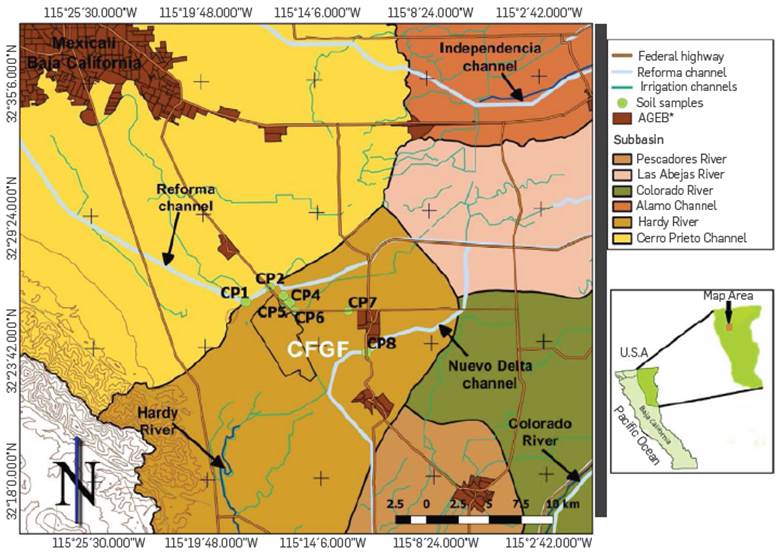
Figure 4 Hydrology map of the vicinity of Cerro Prieto Geothermal Field (CPGF) in Mexicali Valley, BC, Mexico (González-Acevedo et al., 2018)
THE LOS AZUFRES GEOTHERMAL FIELD (LAGF)
With a 247.9MW installed capacity, the Los Azufres Geothermal Field (LAGF) is Mexico's second most productive geothermal field, behind Cerro Prieto. The LAGF is located in the heart of the Trans-Mexican Volcanic Belt, 250 km west of Mexico City (Wen et al., 2018). Los Azufres is 80 km east of Morelia, and 16 km northwest of Ciudad Hidalgo in Michoacán, which was found and developed in 1982. Initially, it was classified as a liquid-dominated high-temperature system. Several thermodynamic investigations have found three types of reservoirs; upper-vapor-dominating valleys surround this location, which is 2500-3000 meters above sea level.
With 43 production wells, six injection wells, and 185 MW generated by one 50 MW condensing unit, 4 25 MW units, and 75 MW back pressure units, the Los Azufres geothermal field is now fully operational. In the northern part of the field, a 50 MW condensing unit will replace four 5 MW units, totaling 215 MW (Abraham III, 2013). Its volcanic complex, which is covered in Quaternary dacites and rhyolites and contains Miocene andesites, is where its geothermal activity is centered. Part of the Morelia-Acambay east-west rift zone includes this region (Wen et al., 2018). Figure 5 shows this field.
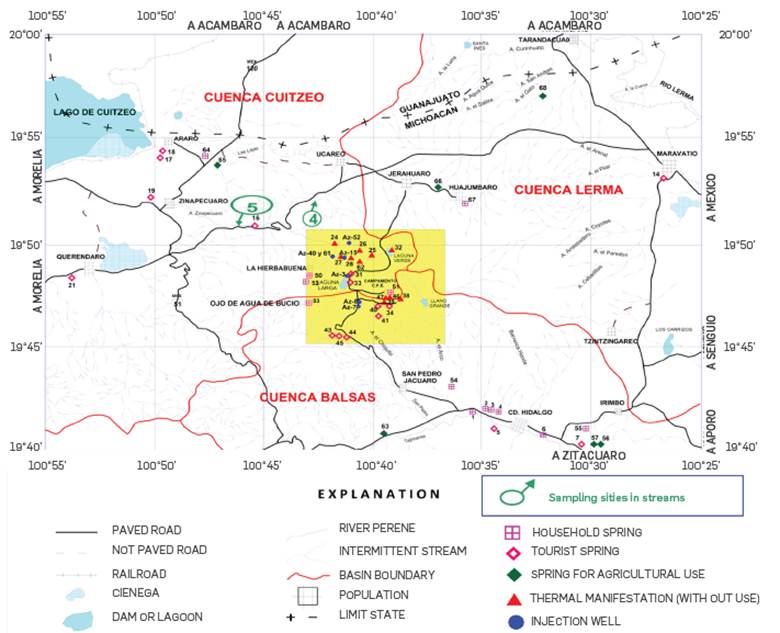
Figure 5 The geothermal field of Los Azufres and its surface manifestation (Abraham III, M. M., 2018)
Seventy-five wells have been sunk between 700 and 3500 meters deep. To fulfil a services agreement between CFE and the Instituto Costarricense de Electricidad, two 5 MW power units (U-1 and U-2) were dismantled and transferred to the Miravalles geothermal field in Costa Rica in 1996. At that time, the installed capacity had reached 98 MW. One of these units, U-2, returned to Los Azufres in 2000, and the 5 MW unit number 8 was disassembled and relocated to Mexico's Los Humeros geothermal region in 2002.
Los Azufres II project, which involved the construction of four condensing power units with a combined capacity of 25 MW, was started in 2001. The installed capacity is 188 MW at the moment. Forty-three producing wells provide 1630 t/h of steam to maintain generation. In six injector wells west of the field, 891 t/h of brine and condensed steam are injected simultaneously. Binary cycle units receive 280 t/h of these before being transported to the injection system (Torres-Rodríguez et al., 2005).
LOS HUMEROS GEOTHERMAL FIELD (LHGF)
The eastern part of the Trans-Mexican Volcanic Belt includes the Los Humeros geothermal area in Puebla, Mexico (TMVB). It is the third-largest geothermal field in Mexico, behind Cerro Prieto (570 MW) and Los Azufres, and it is currently operated by the National Mexican Electric Corporation (CFE) (225 MW) (Peiffer et al., 2018). The Los Humeros Volcanic Complex has been studied for decades, and it is a geomorphologically notable circular caldera complex with a 5-- 8 km diameter oval caldera (Los Potreros). It is a Pleistocene basalt-andesite-rhyolite system currently used for geothermal energy. This volcano lies in the Serdán-Oriental Basin, west of the Citlaltépetl-Cofre de Perote volcanic range (SOB).
At least two significant caldera collapse occurrences, the Los Humeros and Los Potreros calderas, occurred roughly 460 and 100 thousand years ago, respectively. Welded ignimbrite deposits that serve as a low-permeability barrier restrict the movement of geothermal fluid between the reservoir and the surface. Hence, there are not many thermal surface manifestations inside the caldera. They mostly form steaming grounds and weak steam vents at specific locations linked to advanced argillic alteration (Peiffer et al., 2018). Figure 6 illustrates the geological map of Los Humeros.
Sixty wells have been drilled in the geothermal reservoir in the past 40 years. Infield reinjection started five years after geothermal energy was first used commercially in 1938. Currently, 28 production wells are producing at a rate of 663 t/h, while three 2200 m deep wells are used to reinject geothermal fluids. The quantity of reinjected fluids at Los Humeros is based on the readily available brine, which has never been very high compared to the volume of produced fluids. Injecting the proper number of fluids without lowering production enthalpies is a delicate balancing act. However, an increase in reinjection rates typically occurs in response to an observable reduction in productivity. To increase the volume of fluids used for reinjection, Los Humeros geothermal operators have recently added condensing technology to the generating units (Jentsch et al., 2021).
LAS TRES VÍRGENES GEOTHERMAL FIELD (LTVGF)
The Comisión Federal de Electricidad (CFE) of Mexico's Las Tres Vrgenes Geothermal Field (LTVGF) is the country's most minor high-enthalpy geothermal field (Hernández Hernández et al., 2019). This volcano lies 35 km northwest of Santa Rosalía, Baja California Sur. The transtensional tectonic region of this complex contains the right-lateral displacement fault system that separates the Baja California peninsula from western Mexico (pull-apart). La Reforma caldera (LRC), El Aguajito caldera (EAC), and Tres Vírgenes volcanic complex (TVC) are three Quaternary volcanic complexes in the region (TVVC). This complex includes La Virgen (LVV; 112 21 ka), El Azufre (EAV; 146 22 ka), and El Viejo (EVV; 245 39 ka). These Quaternary volcanoes built on a Cretaceous granodioritic base are overlain by the Comond group, a volcanic sedimentary sequence, and shallow marine deposits (99.1 0.8) (Sena-Lozoya et al., 2020).
Eleven wells had been drilled in December 2013, with depths ranging from 1291 to 2505 m. Four producing wells, three reinjection wells, and four exploration wells are currently operational. The limited permeability, low recharge, and severe carbonate scaling of the LTVGF create several difficulties. However, due to the absence of conventional energy resources in the region, efforts are still being made to develop this challenging geothermal sector, making geothermal energy one of the most affordable and practical sources available (Hernández Hernández et al., 2019). Figure 7 shows the Quaternary volcanoes of central Baja California, California.
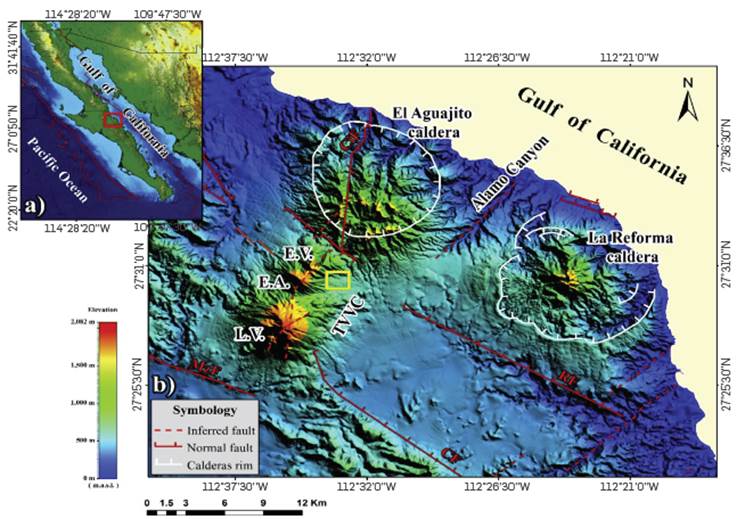
Figure 7 a) Quaternary volcanoes in central Baja California, Mexico (red box). b) The main structures are the Las Tres Vírgenes (TVVC) system of aligned volcanoes, which includes La Virgen (L.V.), El Azufre (E.A.), and El Viejo (E.V.); the Las Tres Virgenes geothermal field (LTVGF; yellow box); and the El Aguajito and La Reforma calderas, which are both bounded by the Alamo Canyon (Sena-Lozoya et al., 2020).
DOMO SAN PEDRO GEOTHERMAL FIELD (DSPGF)
The topography of the Domo San Pedro (DSP) geothermal field in the Nayarit state varies from 1800 m above the Domo San Pedro to 800 m above the bottom. The DSP project is located within a silicic volcanic complex that erupted 100,000 years ago. An alignment of several monogenetic silicic cinder cones in a NNW-SSE orientation with a WNW-ESE alignment to the north of monogenetic volcanoes and the Ceboruco stratovolcano (0.045Ma) represents the most recent volcanism.
There are nine geothermal wells in the Domo San Pedro geothermal field, four of which are production wells, and one is a reinjection well. Other wells have been used as reinjection wells or monitoring wells sporadically. The wells are arranged in an E-W pattern along the northern edge of the domes. Most of the warm springs of the domain complex discharge east and southeast (Rodriguez et al. 2019). Figure 8 shows the geological map of Domo San Pedro,
4. SCENARIOS FOR THE TRANSFORMATION OF THE MEXICAN ENERGY
Concerns about energy security, intergovernmental relations alliance formation, advocacy, and defense programmers. Oil nterests have for long shaped the relations between the Middle East and the United States of America. China and the European Union also need secure sources of suppliers for their economic development. Most countries will become energy independent in a renewable energy economy because they have more freedom of action for their energy strategies and international relations. With such economic interaction, the importer of hydrocarbon resources will not have to worry about terrorist attacks, military conflicts, political instability, and consequent price changes.
The trend of the global energy system impacts each country's local energy environment, including Mexico. Various causes have contributed to the continuous increase in worldwide demand for primary energy over the past century, including the enormous improvement in living standards in the West and China's fast industrialization. However, with a trend toward service-orientated economies and increased energy efficiency, this level of demand is likely to stabilize in 2030.
Furthermore, fundamental market disruptions will occur between now and 2050, with implications for stakeholders, energy producers, governments, and consumers. According to our research, Mexico has the potential to become one of the world's energy centers with the right investments. It has access to various fossil and non-fossil energy sources, including oil, gas, solar, wind, and geothermal energy, low-cost oil production, deep gas markets, and significant renewable energy development capabilities. However, having access to resources does not guarantee that you will pay a reasonable price. Mexican consumers have not perceived any benefit from the country's reliance on fossil fuels. The energy cost per unit of production in the industrial sector has continuously increased over the last five years.
The shift from fossil fuels to a wide range of renewable energies has the potential to boost Mexico's energy sector's economic competitiveness. Mexico may establish investment plans as part of its energy strategy to position itself as a global energy leader. Changes in the energy sector have far-reaching consequences for industry players regarding their obligations and the products they provide. These changes include business improvements (as fossil fuel companies migrate to other energy sources or invest in storage solutions), altering market dynamics (as priorities shift and the value chain shifts), and changes in government laws and regulations (such as new directives and performance standards affect energy prices).
Figure 9 shows Mexico's share of each power generation source in 2018. Geothermal energy, with 5 fields introduced and studied in the previous section, provides only 1% of the required power of the country. Given the energy outlook and the policies pursued, this amount should be expected to increase significantly by 2035 (Billarent-Cedillo et al., 2021; Espinoza-Ojeda et al., 2021; Prol-Ledesma & Morán-Zenteno, 2019). Figure 10 also shows a bar graph of the installed capacity, operating capacity, and production capacity of Mexico's five geothermal fields. The most crucial geothermal field in Mexico is the Cerro Prieto Field, and Las Tres Vírgenes and Domo San Pedro do not have much production capacity and are prone to further development.
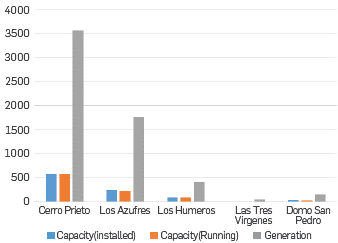
Figure 10 Geothermal energy capacity (MW) and generation (GWh) in Mexico by fields (Gutiérrez-Negrín, 2019)
The energy sector is at a fork in the road, and the actors in the Mexican energy sector need a way forward. The Mexican Energy Outlook examines the consequences of implementing a cost-effectiveness policy, and two other possibilities. The energy sector in the cost-effectiveness scenario focusses on lowering the country's overall energy costs, which significantly impacts cost competitiveness. On the other hand, the first alternative scenario prioritizes domestic development above cost efficiency, with local investment and tax revenues taking precedence. The essential instruments in this circumstance are government rates, and supply security.
The second scenario studies the accelerated situation, highlighting how technology developments can accelerate the adoption of renewable energy. These three choices have substantial disadvantages and benefits that will affect the Mexican energy system within the next decade. They all convey the same message: Demand for fossil fuels will finally fall, and renewable energy will be taken over. Due to advances in energy efficiency and the electrification of sensitive industries, Mexico's main energy consumption is predicted to be reduced in the cost-effectiveness scenario. In 2007, the demand for oil in Mexico declined, while the demand for coal slowed in 2011. Following that, forecasts for the competitiveness of geothermal, solar, and wind energy anticipate that gas consumption will peak in about 2030. New renewable energy is increasing 7% each year, and it will replace fossil fuels as soon as practical after 2030.
Mexico's main energy consumption would continue to expand at a rate of around 1% per year under the domestic development scenario, but at a greater cost to the economy. Beyond the capacity for wind and solar electricity, local oil and gas production and refining facilities could match the demand for fossil fuels by the late 2030s, although at a higher energy cost to consumers. On the other hand, policies that slow down energy transformation will have a limited impact in the long run because, despite short-term decisions, the renewable resource economy will eventually win.
Finally, the most extreme Accelerated Transformation scenario recommends faster clean energy and unbridled emission reductions. The method suggests that costly and technological advances will reduce Mexico's demand for primary energy by 7% as compared to the cost-effectiveness scenario. Domestic demand for fossil fuels will soon cease. To achieve this scenario, a rapid productivity process is essential, both globally and domestically.
Government officials have set high goals and objectives, although there has been some growth in the field. The goals established by the Mexican government include 25% by 2018, 30% by 2021, 35% by 2024, with a final target of 50% by 2050. The objective is achievable for the following year, with the current ranks falling by almost 22% by mid-2017. Enough expansion has taken place to meet the need since these explicit goals were stated.
"In this revitalized market, procurement possibilities will materialize in one of four ways:
Directly selling electricity to suppliers or approved customers (major electrical consumers who purchase electricity from suppliers or the National Centre of Energy Control (CENACE) at unregulated rates);
Selling electricity on the wholesale market; official emblem of CFE.
Participating in long-term auctions for capacity and service supply.
Cooperation on projects with the CFE or its affiliates.
Despite some growth in the field, government officials have set high goals. The Mexican government has set targets of 25% by 2018, 30% by 2021, 35% by 2024, and a final goal of 50% by 2050. With current ranks reducing by roughly 22% by mid-2017, the goal can be achieved for the following year. Since these specific objectives were set, sufficient expansion has fulfilled the need. Procurement opportunities in this revivified market will take one of four forms:
Directly selling power to approved customers or suppliers (i.e., large electrical consumers that buy electricity at uncontrolled rates from suppliers or the National Center of Energy Control (CENACE));
The official CFE symbol is used when selling power on the wholesale market;
Participating in lengthy capacity and service supply auctions;
Collaboration on initiatives with the CFE or its affiliates is an issue.
The main concerns include reaction and support on the political, social, and economic platforms. Soon, the laws that are being formed will control these ideas. It is essential to consider specific landowners and residents. The opinions of these individuals will be considered, resulting in more widely accepted agreements and positions. These folks will be in charge of implementing these initiatives and moving them through. The nation's citizens should also have access to higher education and knowledge. The public's access to this information will boost cooperation on upcoming projects. In sum, even if these goals are ambitious, they can be achieved with the appropriate strategy and introduction of something new. The ability of Mexico's energy sector to overcome challenges and probable setbacks will determine its future success.
CONCLUSIONS
The Earth is a vast energy source and geothermal energy originates from the energy stored inside the Earth for thousands of years, as well as the decay of radioactive elements deep in the Earth. Geothermal energy is the heat in the depth of the earth, and heat increases as it goes deeper into the earth. This energy is considered one of the new and renewable energies. New energy sources are essential as they are an excellent alternative to fossil fuels. Fossil fuels have caused environmental and climate pollution, and are also nonrenewable; hence, the world is looking for clean and renewable energy.
Although Mexico was a pioneer on the American continent in the commercial generation of electricity from geothermal resources and its tradition in this area, which dates back more than a half century, should be well established, it is true that geothermal development in the country has slowed significantly in recent years. This requires a thorough review of the obstacles and events that have led to this point. Given this research, the technological and other constraints that must be addressed to return to the sustained development of geothermal energy in Mexico must be specified. The new geothermal laws and energy changes are aimed at reviving the sector's growth. Promising statutes, regulations, and forecasts for increasing power consumption and up to 25 GW of untapped geothermal potential could entice new investment in Mexico's geothermal energy sector. The recent restructuring of the power market may allow for more competition and private investment, allowing US geothermal firms and equipment makers to benefit from these new rules and existing trade agreements to help Mexico fulfil its ambitious geothermal energy deployment targets.
Although the Federal Electricity Commission is responsible for all geothermal energy generation, private investors have had the legal option to engage for a long time. However, other technologies, notably natural gas-based combined cycle plants, have favored CFE and commercial power companies. Geothermal energy is offered as a less competitive option from a strictly economic perspective, in an environment where greenhouse gas emissions translate into environmental harm costs.
As demand for Mexican petroleum products increases in the coming years, a new investment plan to supply Mexico with competitive gasoline becomes more critical than ever. The Mexico Energy Outlook Reference Case demonstrates that Mexico's cessation of fuel consumption is mainly determined by industrial sector efficiency and electrification, which is entirely achieved through electric cars. Industrial companies must reassess their energy operations throughout the value chain, particularly equipment electrification and energy efficiency implementation. The government must also provide h the necessary conditions for a good investment.
Energy systems have a strong influence on all aspects of our life. It supplies energy for our automobiles, cell phones, and houses. Thus, the industry's future must reflect long-term development over the next decade. Mexico is no different. Industry and government authorities must devise strategies to adapt to increased demand while decreasing prices. There is still more to be done in this area. The data and numbers contained in this study will point the way toward a more sustainable and efficient energy system.
The world's geopolitical map has been based on oil, gas, and hydrocarbon energy sources for more than two decades. Since then, control over the production and trade of these resources has determined power politics. Many analysts believe that switching from these sources to new energies, including renewables, could transform global power relations. Thus, changes in energy resources can be one of the components in depicting the geopolitical developments of the 21st century, along with demographic trends, technology, environmental sustainability, military capabilities, and the domestic policy of governments. One of the possible consequences of energy developments will be the reduction in the geostrategic importance of oil and gas as a foreign policy tool. Countries with these resources will not use hydrocarbon energy as coercive diplomacy. Or vice versa, this diplomacy will not be used against the holders of these resources, as happened in Iran. This means that, on the one hand, hydrocarbons are tools of those in power and their exporters, and, on the other hand, they will be a factor for pressure. This is true even for transit and energy transmission corridors, as evidenced during the conflict between Russia and Europe and Russia's cutting of gas arteries in Europe.













